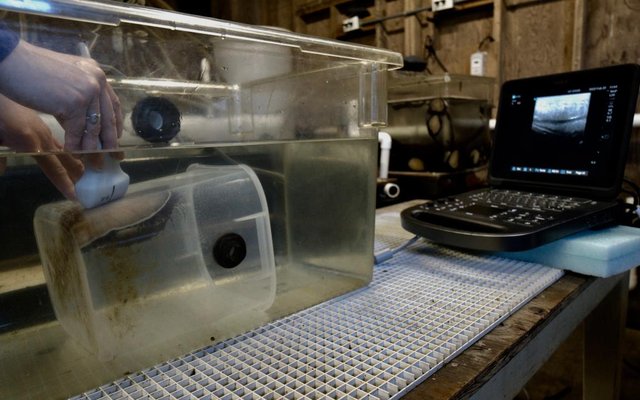Scientists from the University of California, Davis, found that an ultrasound transducer can be used to quickly and noninvasively detect when abalone is ready to spawn. The technique is expected to help abalone farmers and captive breeding managers produce more abalone, with minimal stress to the animal.
Increasing abalone welfare
Abalone suction onto surfaces and typically have to be pried off for gonad inspection before spawning. For these animals, the less they are handled, the less opportunity for stress or physical harm.
“There are not a lot of animal welfare methods applied to invertebrate animals, let alone for aquatic species,” said corresponding author Jackson Gross, an assistant professor of Cooperative Extension in Aquaculture with the UC Davis Department of Animal Science. “Here’s a way to increase the welfare of an abalone without bringing added stress to them.”
The United States Navy’s Pacific Fleet funded the research as part of its efforts to conserve federally endangered black abalone and find better ways to assess their reproductive health. Because of black abalones’ low numbers and high vulnerability, the authors used closely related farmed red abalone to test the effectiveness of ultrasounds on abalone.
Gross used the technique for gonad assessments on sturgeon and catfish, but it had never been tested for sea snails until this study. When Gross saw a video of a veterinarian in Scotland conducting an ultrasound on a large land snail, he felt certain it would work for abalone.
Testing the tech
With Gross’ background, the extensive knowledge of the white abalone captive breeding program at the UC Davis Bodega Marine Laboratory, and first author Sara Boles’ experience studying red abalone, the authors tested the method on 12 farm-raised red abalone and about 100 red abalone raised at Bodega Marine Lab. They monitored the lab-raised abalone for seven weeks to detect seasonal changes in their gonad size.
They found that ultrasounds could differentiate reproductive tissues from digestive tissues. They were then able to create a gonad index score ranging from 1 to 5 that indicates the abalones’ readiness to reproduce. Abalone measuring in the 3 to 5 range could be ideal candidates for spawning. They also found the technology was sensitive enough to detect changes both before and after spawning.
“This is very helpful for broodstock managers when trying to select individuals for a spawning season, whether for production aquaculture or conservation,” said Boles, a postdoctoral researcher with the UC Davis Coastal and Marine Sciences Institute at the Bodega Marine Laboratory.
How to give abalone an ultrasound
To ultrasound an abalone, it has to be submerged underwater in its tank and the ultrasound transducer is placed on the outside of the tank by the abalone’s foot. The sound passes through the tank and transmits the image. Routine assessments using ultrasounds can be conducted without touching the animal at all. Abalone still have to be handled for spawning events, but ultrasounds can minimize the handling involved.
Check out the study here.













